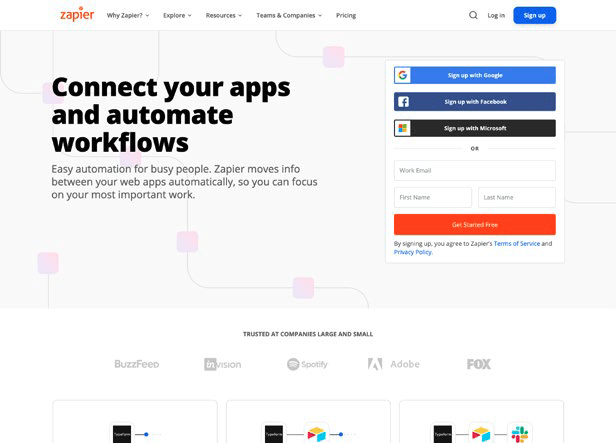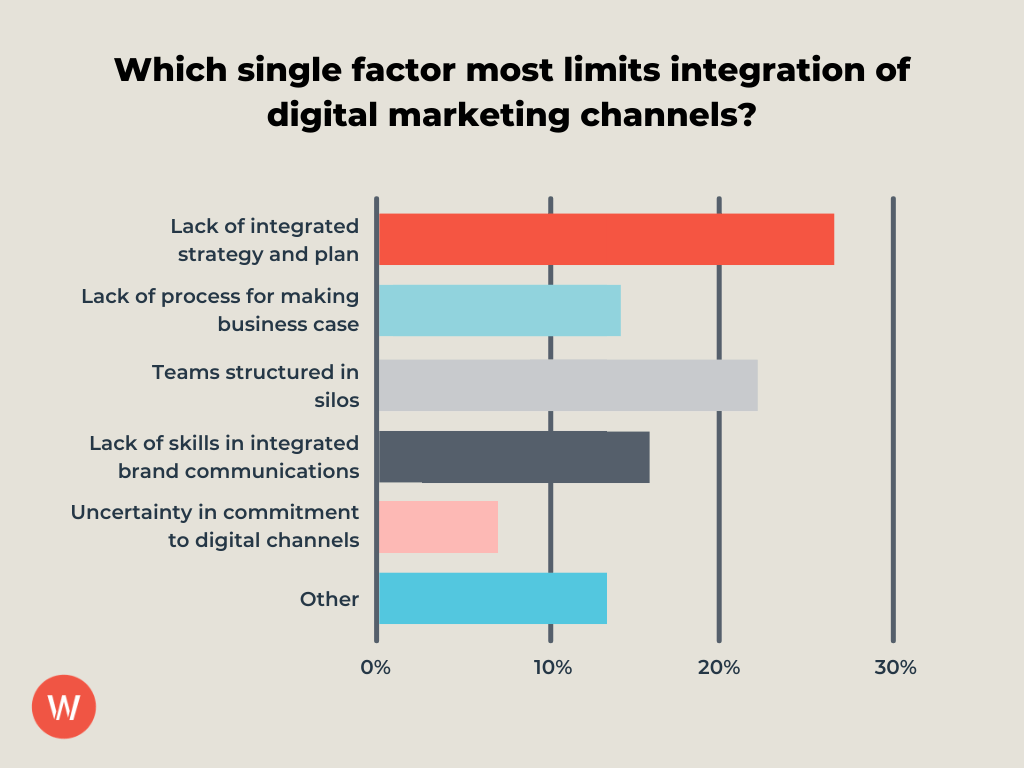Consumers are checking emails on tablets, purchasing on desktop, and using mobile to research products when they shop in stores. Today’s modern shoppers don’t see channels; instead, they choose to interact with the brands they love on the platforms that are the most convenient for them—all the while expecting a consistent, seamless, tailored experience every step of the way.
Meeting the needs of today’s customers requires unifying your marketing teams and data to achieve holistic channel integration: a full-funnel strategy that allows your brand to be present across the customer journey and engage with audiences on every channel and platform.
But mastering channel integration remains one of the biggest challenges for marketing departments, especially in our increasingly fragmented world. It requires bringing everyone together with common goals and strategies—and while that may sound pretty straightforward, many companies struggle to make it a reality.
In fact, only 14% of organizations say they are currently running coordinated marketing campaigns across all channels, according to a CMO report by Adobe.
Brands interested in achieving meaningful profitable growth must first learn how to eliminate marketing silos and align all of their channels with their broader business strategy.
What is integrated marketing, and why is it so effective?
Integrated marketing refers to aligning your marketing channels to promote your products or services in tandem, typically through a strategic campaign.
While integrated marketing campaigns can have their own individual goals (e.g. building brand awareness, converting views, increasing ROI, etc.), they should all have one component in common: to support and communicate your brand’s value proposition through all of your marketing channels and assets to create a more unified, customer-first experience.
There’s no question that integrated marketing campaigns are more effective at driving performance compared to campaigns that run on individual channels, but here are the main ways they impact your bottom line:
- You can reach a wider audience with integrated campaigns than through single channel campaigns
- Consistent interactions across multiple channels keep your brand top-of-mind and push visitors closer to conversion
- Promoting consistent messaging on multiple channels builds trust and mitigates frustration or disconnects with your audience
- Assets can be shared between and repurposed for different marketing channels, contributing to more efficient budgets
Integrated marketing campaign example: Zapier
From the beginning, the team at Zapier recognized that a great product is only as successful as the marketing behind it: they invested early in earned media and SEO, building out a strong foundation of optimized content for hundreds of integrations. Zapier partnered with Wpromote to branch out to new audiences by building on that organic success through a new channel: paid search.

Paid search was an ideal fit for a B2B SaaS business that counted educational content and a sophisticated SEO strategy as its primary growth tools. The team focused on building out a holistic search strategy in which SEO and paid search campaigns worked together.
Paid search campaigns also meant that Zapier could expand coverage and get their content to the top of the search results for extremely competitive keywords where an organic breakthrough was unlikely. They could also focus on new customer acquisition, capitalizing on the accessibility of Zapier’s technology to spread the word and help the business level up the adoption curve.
Results:
- 85% increase in monthly sign up volume
- 21% increase in monthly activation
- 63% increase in monthly upgrade volume
- 67% decrease in registration CPA
- $50 decrease in activation CPA
Make the move to holistic channel integration
It’s important to keep in mind that you’ll likely need to tweak your approach and make ongoing optimizations over time. The more data you collect, the better you’ll understand your customers’ integrated buying experience, which in turn gives you insights into improvements you can make over time.
With that in mind, we want to share two of our top proven strategies to get you started:
Bring your teams together on every level
It’s highly likely that your marketing team is structured around individual channels or business verticals, but that’s not how the customer actually experiences your brand: remember, there’s no such thing as a “paid search customer,” just a customer.
According to marketers themselves, approval delays are a major reason deadlines are missed, which also speaks to the inconsistent expectations and lack of communication that typically occurs throughout most organizations.

It’s more important than ever for brands to prioritize bringing their teams together on every level—or risk hindering the customer experience and losing valuable market share.
The different teams within your marketing department, including paid media, search, social, email, SEO, etc., need to work together to identify goals and generate mutually beneficial end results. This close-knit partnership is also necessary when it comes to creating and deploying the most optimal content to the right audience at the right time.
In order to start breaking down silos and building bridges, you need to focus on two main areas: consistent communication and strategic direction. One way to approach this is by applying the “One Team” mentality:
- Touch Base: Maintain clear and consistent communication across disciplines, while building strong connections across disciplines and areas of expertise.
- Exchange Ideas: Understand the goals and strategic direction of each team to identify opportunities for support and amplify each others’ efforts.
- Alignment: Understand the objectives each team is driving towards and what “swimlanes” needs to be implemented to avoid inefficient overlap.
- Measurement: Develop a holistic overview of the full customer journey across multiple touchpoints in a central dashboard.
Develop common strategies across marketing channels
Those shared goals and strategies are crucial to marketing success. In fact, an estimated 60% of Millennials report that they expect a consistent experience whether they are in-store, in-app, online, or a combination of all three.
To create this type of integrated experience, focus on the following areas:
- Define your buyer personas by channel
- Know exactly who your brand is targeting for a particular campaign, including where they are interacting and how they like to shop. Instead of building a broad persona for your campaign, define your audience by channel and identify where overlaps are likely to occur. While there will likely be some overlap, it’s important to understand exactly who you’re talking to on each medium and how you can tailor those specific assets to achieve greater results.
- Create uniform, integrated messaging
- The importance of conveying a consistent message across all of your media channels cannot be overemphasized. This includes the visual elements such as colors and graphic design, but it’s equally as important to convey a consistent tone and product emphasis. This means using similar language, visuals, and designs to tie the campaign together.
- Implement integrated reporting
- It’s impossible to understand data (or a customer, or a purchase) in a vacuum, so you need the right technology and reporting in place to be able to see the full scope. That’s the only way to really grasp the fluidity within the customer journey and see where the data takes you as you drill down into specific paths.
- Play to the strengths of each channel
- While consistency is absolutely vital, that doesn’t mean that you should simply create carbon copies of your campaigns and repeat them across all of your media channels. Play to the unique strengths of each channel in a manner that will engage the shoppers who prefer those particular platforms. For example, you could develop a downloadable app for your mobile visitors, or boost the conversational quality of your communications for your social media shoppers.
Test, measure, and iterate your learnings
With multiple channels in play, you need to make sure you understand how to appropriately evaluate performance across the funnel in order to accurately measure success. Consider what attribution model will work best for your business:
Linear Attribution Model: Attribution to all touchpoints equally per sale
- Pros: Shows a much more full picture of the customer journey, allowing marketers to analyze all the steps taken to complete conversion actions
- Cons: Because equal credit is distributed between all actions in a multi-touch conversion, it could grant more or less credit than is deserved to certain clicks
Time Decay Model: More attribution to the most recent touchpoints
- Pros: Puts more emphasis on actions that are lower down the funnel, providing key insights to brands with a long sales process
- Cons: Can undervalue the touchpoints in between the first and last clicks
Position-Based Model: More attribution to touchpoints along certain stages of the lifecycle of the lead
- Pros: Recognizes that the most important steps in the customer conversion journey are generally the first and last clicks, while still giving credit to the clicks in between
- Cons: Similar to the Time Decay attribution model, this method isn’t exactly accurate in weighting importance and distributing conversion credit
Algorithmic Multi-Touch Model: Attribution at every user touchpoint on the basis of their true contribution to conversion
- Pros: By optimally measuring the performance of every touchpoint (and user actions during those touchpoints), algorithmic MTA (multi-touch attribution) is the gold standard when it comes to attribution.
- Cons: Can be complicated to implement, requiring expert knowledge, complicated calculations, technology, and algorithms
You need to prioritize new learnings by tracking each aspect of your integrated marketing campaign against a testing roadmap so you can identify which parts of your creative are getting results and scale those elements across your paid channels.
Start by setting up a test and learn agenda: dedicate a portion of your budget to testing growth strategies that will directly impact your core programs, instead of just assuming that what is working now will work in the future.
Integrated marketing campaign example: Helzberg
Helzberg went into 2020 ready to focus on building out their ecommerce business, but the pandemic required an even sharper focus on digital marketing. In the second half of the year, Helzberg used Wpromote’s keyword cohort analysis to leverage paid insights to inform SEO technical optimizations and content creation.

Helzberg also brought that educational, early funnel approach to paid social acquisition, building new creative mirroring the new content, like an engagement ring buying guide or lab-grown vs. natural diamonds.
That meant that Helzberg’s messaging was more cohesive for customers while still tailored to perform on each channel. They also developed more effective omnichannel reporting to ensure they were balancing both performance and brand marketing instead of over-indexing on direct response.
Results:
- Since the All About Lab Grown page went live in early February, it has grown from ranking for 3 keywords to 267 in March, driving 741% increase in sessions MoM
- Implementation of DSAs drove a +44% higher CTR than search average, at a 63% lower cost per qualified user
- March 2021 saw the largest increase in YoY Organic sessions since December 2016
- 179% increase in Organic Search assisted conversions due to quality traffic driven by content that helps people throughout their research journey to eventually purchase online or in-store







Responses